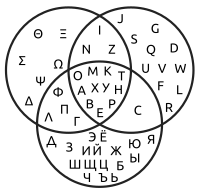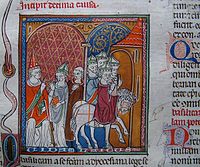|
Vikidia currently has 4,621 articles. Improve it! |
|
Join Vikidia: create your account now and improve it! |
Alphabet

An alphabet is a writing system, a list of symbols for writing. The basic symbols in an alphabet are called letters. In an alphabet, each letter is a symbol for a sound or related sounds. To make the alphabet work better, more signs assist the reader: punctuation marks, spaces, standard reading direction, and so on.
The name alphabet comes from Aleph and Beth, the first two letters in the Phoenician alphabet.
The alphabet in this article is the Roman alphabet (or Latin alphabet). It was first used in Ancient Rome to write Latin. Today many languages also use the Latin alphabet: it is the most used alphabet today.
Short list of alphabets[edit | edit source]
A list of alphabets and examples of the languages they are used for:
- Proto-Sinaitic script
- Phoenician alphabet, used in ancient Phoenicia.
- Greek alphabet, used for Greek
- Roman alphabet (or Latin alphabet), most commonly used today
- Arabic alphabet, used for Arabic and Persian
- Hebrew alphabet, used for Hebrew, Ladino (only in Israel) and Yiddish
- Cyrillic alphabet, which is based on the Greek alphabet, used for Russian and Bulgarian
- Hangul, used for Korean
Alphabets[edit | edit source]
It seems that the idea of an alphabet – a script based entirely upon sound – arose only once, and has been copied and adapted to suit many different languages. [1]p12
Our alphabet is called the Roman alphabet, as compared with the Cyrillic and other alphabets. All of these come from the ancient Greek alphabet, which dates back to about 1100 to 800BC.[2]p167 The Greek alphabet was probably developed from the Phoenician script, which appeared somewhat earlier, and had some similar letter-shapes.
The Phoenicians spoke a Semitic language, usually called Canaanite. The Semitic group of languages includes Arabic, Maltese, Hebrew and also Aramaic, the language spoken by Jesus. We do not know much about how the alphabetic idea arose, but the Phoenicians, a trading people, came up with letters which were adapted by the early Greeks to produce their alphabet. The one big difference is that the Phoenician script had no pure vowels.
No ancient script, alphabetic or not, had pure vowels before the Greeks. The Greek alphabet even has two vowels for 'e' and two for 'o', to distinguish between the long and short sounds.[3] It is fairly clear from this that careful thought went into both the Phoenician invention and the Greek adaptation, but no details survive of either process.[4]
Semitic scripts apparently derive from Proto-Sinaitic, a script of which only 31 inscriptions (plus 17 doubtful) are known. It is thought by some researchers that the original source of this script was the Egyptian hieratic script, which by the late Middle Kingdom (about 1900BC) had added some alphabetic signs for representing the consonants of foreign names. Egyptian activity in Sinai was at its height at that time.[5] A similar idea had been suggested many years previously.[6]
Other writing systems[edit | edit source]
Other writing systems do not use symbols that mean a sound, but symbols that mean a word or a syllable. In the past such writing systems were used by many cultures, but today they are almost only used by languages people speak in Asia.
- Chinese characters are symbols, they mainly represent words instead of sounds.
- Japanese uses a mix of the Chinese writing and two syllabaries called hiragana and katakana. Modern Japanese often also uses romaji, which is the Japanese syllabary written in the Roman alphabet.
- A syllabary is a system of writing that is similar to an alphabet. A syllabary uses one symbol to indicate each syllable of a word, instead of one symbol for each letter of the word. For example, a syllabary would use one symbol to mean the syllable "ga", instead of two letters of the alphabet "g" and "a".
- The Koreans used the Chinese writing in the past, but they created their own alphabet called hangul.
References[edit | edit source]
- ↑ Man, John 2000. Alpha Beta: how our alphabet shaped the western world. Headline, London.
- ↑ Robinson. Andrew 1995. The story of writing. Thames & Hudson, London.
- ↑ Short 'e' is ε epsilon, long 'e' is η eta. Short 'o' is o o micron; long 'o' is ω o mega. Languages other than Semitic have copied the Greek or Roman alphabets, making such changes as seem right for their particular language.
- ↑ Diringer, David 1968. The alphabet: a key to the history of mankind. 2 vols, Hutchinson, London.
- ↑ Sass B. 1988. The genesis of the alphabet, and its development in the 2nd millenium. Wiesbaden.
- ↑ Gardiner, Alan 1916. The Egyptian origin of the alphabet. J. Egyptian Archaeology III.

|
Literature Portal — All articles about literature, books and writers. |

